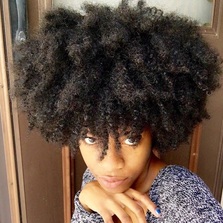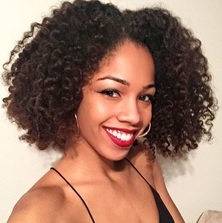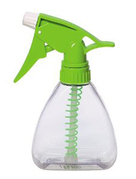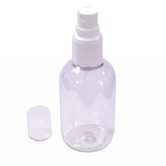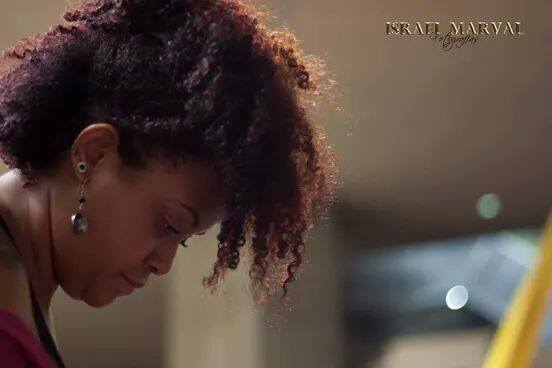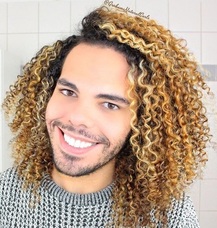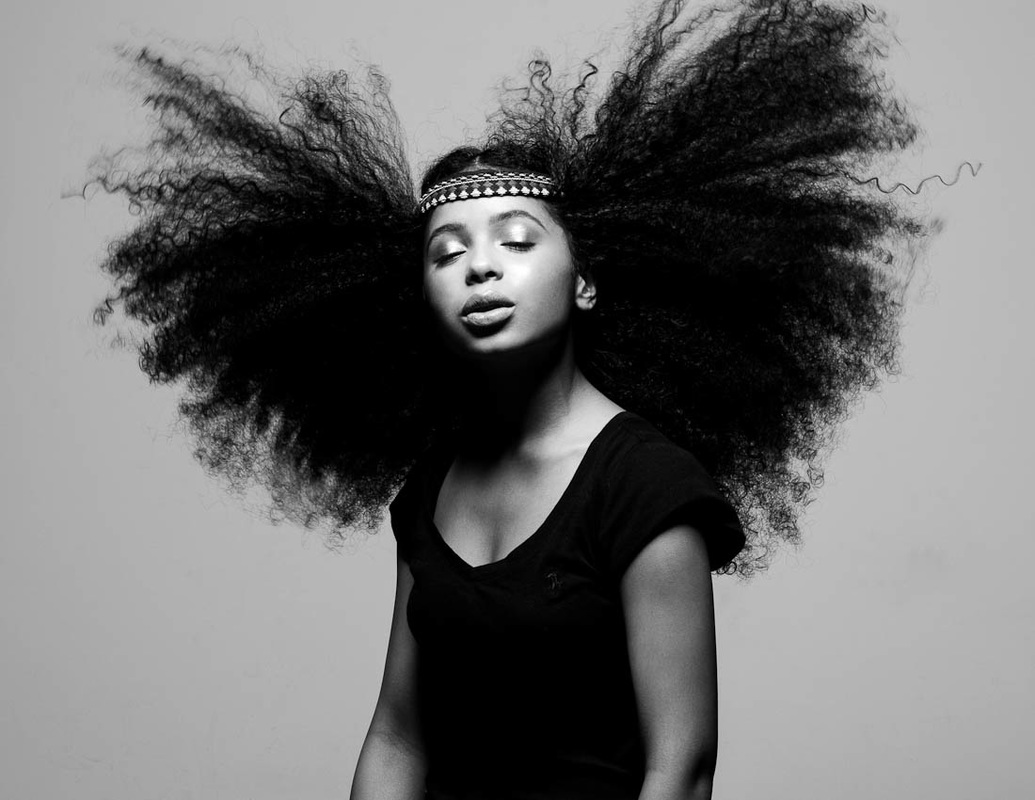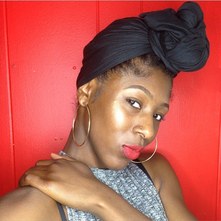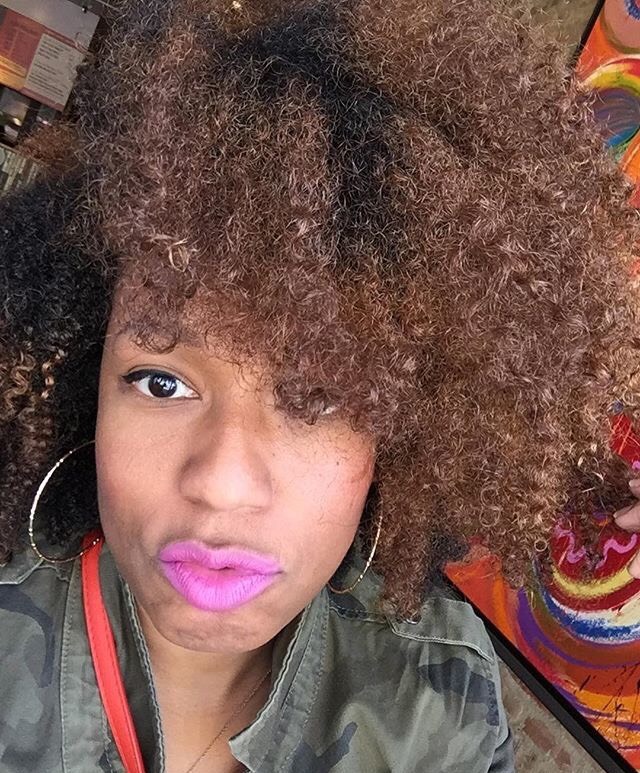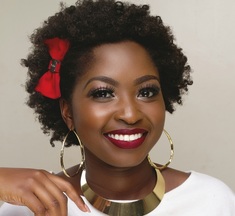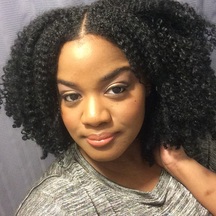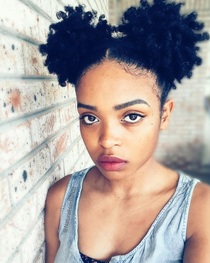
Firstly, why does your hair need any special care in the winter? Plain simply because it's cold and the cold has a tendency to dry hair out. Also, have you ever seen a leaf on a very cold day. It's brittle, I think my hair strands are much more vulnerable than leaves so I'll always spare them exposure to the cold.
So what are your options? 1. Throw a hat and scarf over your head when you go out This simply creates a barrier between the extremely cold weather outside and your temperature-sensitive hair. This is especially useful when your hair is too short to pin in or pin up. 2. Wear completely protective, low manipulation hair styles Completely protective hair styles keep the ends of your hair completely out of site. The best completely protective hair styles are:

This has two benefits:
a. You hair strands are stronger bound together than they are when they're "freely floating". Think about it this way, what's easier to break a single tooth pick or ten tooth picks bunched together. The same applies to your hair. b. The second benefit is that your hair get a break from being combed. Combing is great for detangling hair but it is also the biggest opportunity for breakage. 3. Wear completely protective hair styles You can obviously hide your hair without plaits by:
These are a good alternative to the completely protective, low manipulation hair styles. Remember, it's not just the weather you're protecting your hair from but also the central heating system; hiking the heating in your house up also dries out hair. Also, even outside of winter when it is raining or winding think "protective hairstyle". You might also like: Taking Care of Natural Hair Under A Weave or a Wig 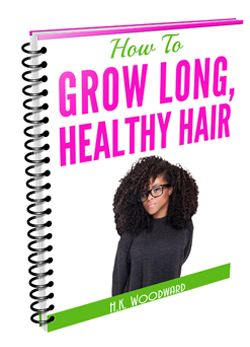
Get your FREE ebook on How To Grow Long, Healthy Natural Kinky or Curly Hair. For any length of hair: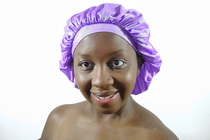 Satin night cap. Satin night cap.
SATIN CAP
Cotton soaks moisture out of hair and is more abrasive against hair fibres thereby increasing the likelihood of breakage. A satin cap doesn't have any of these two problems; it provides the best overnight protection for hair.  Shower caps Shower caps
SHOWER CAPS
A must have for locking heat in when you're conditioning your hair. I usually put one of these on, blow dry on top of it and put a scarf over the shower cap to trap the heat in during a deep condition. 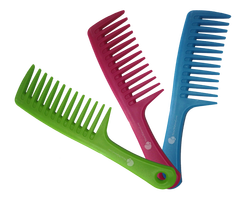 Wide tooth comb set Wide tooth comb set
SEAMLESS WIDE-TOOTH COMB
It's easier to get a wide-tooth comb through kinky, curly or coily hair without hair breakage. Some naturals also like the "Denman" brush. I've had one for years but I stopped using it when I went natural; it still has relaxed hair fibres on it! When I'm less obsessed about breakage I might start using it again. When you've left the TWA (teeny weeny afro) stage you also need: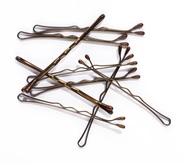
BOBBY PINS
You need these for most styles. Go for those with round ends so that they don't irritate your scalp. One more thing to watch out for, when you slip these out you should hold them apart because if they are too close together they have a tendency to snag and break hair fibres. 
HAIR SIDE-COMBS
This is the best side-comb for natural hair that I have ever found but it's so hard to find! The stems don't break when you slip the comb into hair like I have experienced with other combs. This comb is beginning to look frayed because the top coat is coming off but other than that it's very much intact. 
BUTTERFLY GRIPS/CLAMPS
I actually don't have these myself but I'm planning to get some as my hair is now officially medium length. Hair clamps stop hair that you are not working on from getting in the way during your wash and condition session. 
Get your FREE ebook on How To Grow Long, Healthy Natural Kinky or Curly Hair.
Head lice (Pediculus humanus capitis) are anyone’s nightmare. Adults can get head lice too but the problem is much more common among children because their games often involve close contact.
Lice don’t cause any sort of infection or disease they are just a very annoying parasite. How Are Lice Transferred From Person To Person? One would normally get lice from someone if you share something that the lice have latched on to. Sharing things, for example:
How Do You Know You or Your Child Has Lice? Intense itching on the back of your head or around the neck area. Apparently this itching happens when the lice bite and suck blood out of the scalp. How Do You Identify Lice? These suckers are tiny and they crawl very fast so they can be pretty hard to spot. The easiest way to identify their location is to look out for little white eggs (nits) using a good light. If you have dark hair or dark skin these white eggs will obviously stand out more than if you have light hair and skin. Lice vs. Dandruff Unhatched eggs (nits) are darker in colour and become white when the eggs hatch. This process takes 7 to 11 days after being laid. White, hatched eggs stick to hair when you try to remove them unlike dandruff, which can be more easily flicked or washed out. How To Get Rid of Head Lice
When there’s a lice infestation in a school they normally carry out a large co-ordinated effort involving parents and all teachers to stop it. Kids found with lice may be prevented from attending school until the issue is resolved. 
I'm a scarf lover and I've been wanting to do a scarves for hair video for ages, here it goes!

Get your FREE ebook on How To Grow Long, Healthy Natural Kinky or Curly Hair.
Ah, the natural hair community. Such a wonderful community of fabulous ladies loving and caring for their God-given hair. Since its boom a few years ago, the community has continued to flourish with new techniques and products invented by Black women who have decided to reclaim their hair and image. There have now been more Black women in the media saying no to relaxers and sporting their natural curls than ever before. In the midst of this jubilee of natural hair acceptance, are there still some groups within the natural hair community that remain underrepresented? Do hair types such as thin hair remain in the shadows?
Thin natural hair seems to be an oxymoron within the natural hair community because when people reflect on natural hair, the image of a colossal afro frequently comes to mind. Natural hair only seems thick because curls combined with shrinkage give the illusion of fuller hair but in reality, many are still struggling to fully embrace the thinness of their hair. In the grand scheme of hair, many non-Black people might easily confuse thin natural hair as thick but within the Black community, thin hair does not fall into the Black standard of beauty. Although it is something to be celebrated that Black people are beginning to define their own standards of beauty, it cannot be ignored that not everyone falls under thick hair. Moreover, it should also be taken into account that although relaxer sales are going down, weave sales have remained strong. This is not to condemn any woman who chooses to wear weaves as it can be a great and creative protective style but it begs the question- do we sometimes promote an unrealistic perception of our hair? With the surge of natural hairstyles and flawless concealing methods rising in popularity over the past few years (e.g. Marley crochet, faux locs, clip ins, and weaves in our texture), it would be easy to falsely conclude that all, if not most, natural hair is thick and voluminous. It should be noted, however, that there is a difference between thin and fine hair. Thin hair falls into the category of having low density hair. If one’s hair is thin, then that person has less follicles of hair on one’s head and thus less hair in general. If one’s hair is fine, the diameter of the hair strand is smaller than medium or coarse textured hair. Many people might also fall into both categories.
With all this being said, the community of thin naturals has remained underdeveloped because of the lack of information and acceptance of this hair type. Although there are a booming number of naturalistas on blogs and YouTube, hardly any of them have showcased thin hair. This is not to say that this population does not exist, but many who struggle with this hair type find it difficult to fully embrace it and to display it on the Internet. Hopefully the lack of representation improves in the near future as more women begin to embrace the true nature of their hair.
Jumoke E. Ayo-Ajayi
Copyright: mimagephotography / 123RF Stock Photo
by treasuredlocks.com
As we get older, many of us have to face the fact our hair might want to start showing our age before we are ready. Our hair can begin to gray as early as in our teen years. Graying is fairly common by the time we are in our 30s and 40s. Having your hair dyed in a salon is certainly an option, but it’s expensive, time consuming and who knows what chemicals are used in those dyes? You could dye your hair at home, but again, you have the issue of knowing what’s in the product. And, there is the potential to damage your hair if you don’t do it right. If you’re not a trained professional, dying or relaxing your hair at home can put the health of your hair and scalp at risk. For many years people have been using natural hair dyes. These are usually henna based. These dyes can make hair darker (never lighter). Not only do they not damage the hair, they can actually make the hair healthier, smoother and easier to manage. They are an excellent product for those who can use them. The problem? Gray hairs can be stubborn and difficult to cover. Now there are products that are the best of both worlds. These are henna based dyes with just enough of the chemical components necessary to cover those stubborn grays. These products are easy enough and safe enough to be used at home. Using them saves both time and money. They contain herbs that enhance the health of the hair, while it’s being colored. They are not for everyone. They don’t damage hair partly because they have no ability to lift color. However, because they have no ability to lift color, they cannot make hair lighter. They can only change hair color so much. For example, if your hair is dark, they can add highlights like a reddish tint to it, but you will not be able to get a full red. If these products are suited to you, they are an excellent alternative to harsh chemical products, having to make an appointment and to the on-going expense of having your hair dyed on a regular basis. Many of our customers are freeing themselves from the salons and taking better care of their hair at home. Article courtesy of Treasured Locks, LLC Treasured Locks has been in business since 2002 providing expert advice and premium products for at home hair care. Treasured Locks specializes in the care of natural hair serving tens of thousands of customers all over the United States. For more information, please see www.treasuredlocks.com. If you’re interested in the products mentioned in the article, please visit this page.
Copyright: mimagephotography / 123RF Stock Photo

Grease on my sheets has never been an issue for me. Perhaps it's because I usually massage oil directly onto the scalp; or maybe it's because I have very dry hair that sucks it all in before I go to bed; or perhaps, my satin cap stops grease from flowing out.
Whatever the case I was asked the question so I decided to take a poll on the Facebook page to see what everyone else does and this was the overall conclusion: 1. Apply oil to the scalp Oils are great for sealing moisture in, however, if you're going to bed and you're worried about grease massage the oil directly onto the scalp to stimulate blood flow to the area and hence hair growth. Neno Natural's Hair Growth Stimulator is perfect for that kind of task. 2. Wear a satin cap They can be very effective. I have been using "Stay On Satin" bonnet and for the most part think they are good except for the black version. The black version runs and mixed with hair oils it has permanently spoilt my expensive cotton sheets. If your bonnet feels too tight, open another pack, they don't seem to all be identical in size but that's not a big issue for me because I bought them cheaply. 3. Double up - silk scarf plus satin bonnet This method works for some. Personally, I don't like to get too hot at night so I wouldn't opt for this, I'd rather have grease on my sheets! 4. Use a special pillow case If you want your hair loose and free some opt for a satin pillow case that they wash weekly. 5. Prepare hair hours before bed From my mega oil summary you'll know that some oils soak right through the hair fibre. This is true but the process takes some time. If you want the oil to soak into your hair before bed prepare your hair at least three hours before beddie bye byes! 6. Apply oils and moisturisers only in the morning That way you hair is less greasy before bed. That said if your hair is dry at night you should at a minimum spritz it with water and apply a very small amount of moisturizer. If your pillow does get very greasy, read How To Wash Grease Out Of Bedsheets. 
I should have posted this ages ago but life took over.
I got these braids done on June the 14th so I'll have had them for 4 weeks on July 12th. I think they still have two weeks in them so I'll only take them out on 26th June. I still wash my hair weekly except after I just put them in I waited two weeks before the first wash. These braids are great for hair growth because:
I got these done at a salon. I did allow my hair to be blow dried because as I've mentioned before I find that it leads to reduces tangling so that the braiding can be done faster with less resistance as the lines are drawn. What's slightly unique about the style is that we did single twists in the centre so that when my hair isn't tied up you don't see a gap. It also makes my head look fuller. I like to wear my style in one of two ways.
I always use a large scarf or a medium scarf to create my styles.
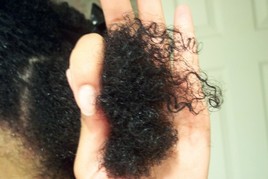
Apparently, and I say apparently because I can't say I noticed this myself but when you go from having relaxed hair to maintaining natural hair the initial texture experienced can be "wiry" and different to the natural hair that will eventually result. This wiry, transitional hair, is scab hair.
The term is not scientific and has nothing to do with actual scabs or sores. My personal opinion is that my new growth is very curly and over time the curl loosens as successive shampoos and styling reduce the ability for my hair to bounce back. This, to me is a little more plausible but who knows?

Get your FREE ebook on How To Grow Long, Healthy Natural Kinky or Curly Hair. 
When you moisturise your hair do you focus on the new growth or the tips of your hair?
It should be the hair tips. The tips of your hair are the oldest section and therefore the most vulnerable to breakage, split ends and fraying. Some fail to retain hair length because this weakness travels up the strand; the dry, weak ends fall off and expose more hair that wasn't vulnerable before leading to the same vulnerability and more breakage. To stop this from happening give the tips extra moisture. Even when your hair is in braids/twists hydrate the ends at least every other day with a hair cream. New growth is much less vulnerable to dryness because sebum (the oil naturally produced by the scalp) can travel part of the way up the hair shaft. The kinks, curls and coils of natural black hair make it difficult for this oil to travel all the way to the tips.
Although new growth is less vulnerable, I personally encourage my hair to grow by massaging our essential oil infused hair oil, Neno Natural's Hair Growth Stimulator, into the scalp. Even if you have braids with extra hair/mesh attached, treat the plaits as though they were your hair by spritzing daily and applying a leave-in conditioner, oil and cream regularly. Your ends will thank you by not breaking off. 
|
I now blog about wealth creation - so if you have any money questions meet me there, you can do all sorts of cool things like leave me a voicemail.
By Heather Katsonga-Woodward
I was a natural hair blogger and mixtress living between London & Chicago from 2012 to 2017. I always thought I was 4C but some say 4B; images below - you decide! Heather xx Categories
All
Archives
November 2016
|

